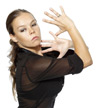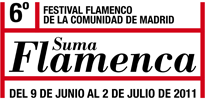
ROCÍO MOLINA
VINÁTICA
Genre: dance

VINÁTICA
“Each one of us, when we take a retrospective look at our own history, will see that our personality as a child, although indivisible, contained different persons, who could remain together because they were in a nascent state. This indecision full of promises is one of the most delightful states in childhood. But, when they grow, the personalities that reached a mutual understanding become incompatible and, given that each one of us only lives one life, we are forced to make a decision. Really, we are always choosing and we always abandon many things. The road we travel in time is covered by the ruins of all that we started to be, the ruins of all that which we could have become.” (H. Bergson).
There is a word, a murmur, or a vibration, which has been given the power to transport us to the icy mausoleum of the past, whose dome seems to remit the present to us as barely an echo. And there are traces of sounds. Scraps. Intermittences. The strange line of things chasing us and which we chase like a dog chases his tail, drunk on the full moon. Drink. Are we perchance drinking to forget? Or is it that we’re drinking to remember? So that the drunkenness of memory barks at the present? Is there not a bitter aftertaste, an insistent “no” in the echo of all wine?
Roberto Fratini
“The term danzaora arose from the need to define the expression of a new language in the world of dance: the danzaor language of Rocío Molina. It is a personal language that is capable of integrating different artistic schools such as flamenco dancing, classical dancing, classical Spanish dancing or bolero and folkdance schools, but which mustn’t be confused with contemporary dance. A new language that summarises its particular view of dancing. If we call Rocio Molina a bailaora the definition would be unfair because it is incomplete and inexact. We would only partly define her as the influence of the schools of dance on her expression is very powerful. And if, on the contrary, we define her as danzarina or bailarina we would cast a shadow over the richness of her flamenco condition and training. The danzaora is capable of assimilating all those sources and integrating them in an original, harmonious and aesthetic way, based on the interrelationships that exist, or can be established, between their elements of origin. She is always investigating with the aim of integrating and with an eye to origins and history. Perhaps that is the key which explains how someone so young can transmit such ancient and original essences.”
Ana Olabarría
The Tower of Babel is a painting by Pieter Brueghel which shows the half built biblical tower, intended by Humanity to reach to heaven, and it was an inspiration to Roció Molina for her new project: “Let’s say that on one side we have the ordered, constructed and classic form, and on the other, the disordered, chaotic form. I like that bipolarity. The contradiction that the right side (unfinished) is an integral part of the harmony shown on the left side (finished, constructed), because one needs the other to be complete.”
Now Rocío Molina is tackling a challenge in her career, that of going a little farther, of working on the deformation of the technique acquired over many years in order to become more aware of its language.
To do this, Rocío Molina has the collaboration of Eduardo Trassierra on guitar; Jose Angel Carmona Manzano “Carmona” on voice, mandolin and electric bass; and the dancer Jose Manuel Ramos “El Oruco” on palmas and compás. Young, well prepared musicians, with a flamenco family tradition and ready to set out on the search that this new creation demands.

- Download full details in PDF

- Madrid
- Teatros del Canal
- Friday 10 june at 20:30

